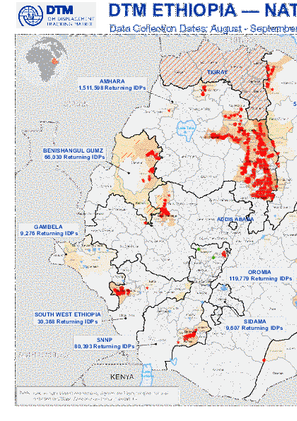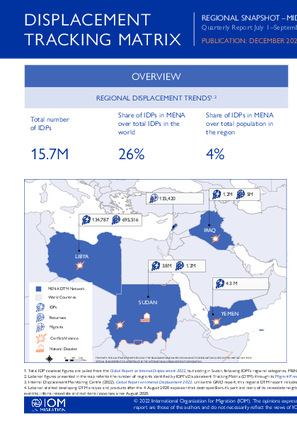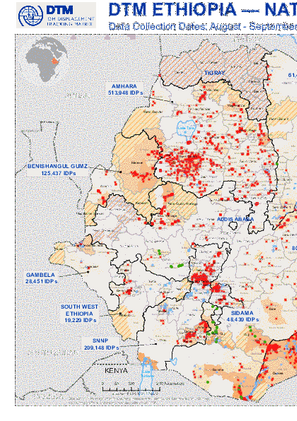-
Countries
-
Data and Analysis
-
Special Focus
-
Crisis Responses
Dec 27 2022
Print
Global
No
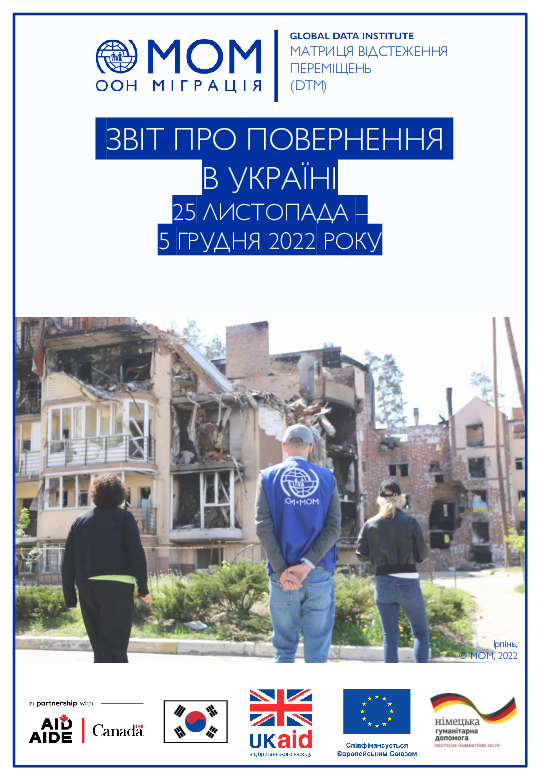
Contact
DTMUkraine@iom.int
Language
English
Location
Ukraine
Period Covered
Nov 25 2022
Dec 05 2022
Activity
- Survey
Після 24 лютого 2022 року повномасштабне російське вторгнення в Україну спричинило безпрецедентну гуманітарну кризу по всій країні, що характеризується, серед іншого, переміщенням значної частини українського населення. Ще у квітні 2022 року Міжнародна організація з міграції (МОМ) почала фіксувати значну кількість повернень.
Умови повернення значно варіюють, оскільки люди повертаються як до регіонів, які безпосередньо не постраждали від війни, але в яких спостерігається значний притік внутрішньо переміщених осіб (ВПО), так і до регіонів, які постраждали від конфлікту, зазнали суттєвих руйнувань та були нещодавно деокуповані. Через нестабільність поточної ситуації неможливо визначити, яка частка людей повертається остаточно, а яка тимчасово. Однак наявні дані свідчать про те, що українці, які повертаються, мають особливий набір потреб і вразливостей, що відрізняє їх від тих, хто нікуди не переміщувався, і від ВПО.
Щоб підтримати партнерів у наданні цільової і доцільної допомоги особам, які повертаються до місць свого звичного проживання після вимушеного переміщення, МОМ презентує цей Звіт про повернення в Україні. Публікація має на меті проаналізувати останні дані МОМ щодо ситуації та потреб осіб, які повернулися, та щодо умов повернення, зібрані в ході оцінювань за Матрицею відстеження переміщень (МВП), проведених по всій країні.
Цей Звіт про повернення в Україні за грудень 2022 року містить детальний аналіз даних, зібраних у ході одинадцятого раунду Опитування загального населення (ОЗН), яке було проведено МОМ у період з 25 листопада по 5 грудня 2022 серед дорослого населення України. Географічне охоплення цього оцінювання покриває всю територію України, усі п’ять макрорегіонів (захід, схід, північ, центр, південь та місто Київ), за винятком Кримського півострова і не підконтрольних українському уряду територій. Опитування загального населення було проведено шляхом набору випадкових телефонних номерів, завдяки чому було анонімно опитано 2 002 унікальні респонденти віком від 18 років із використанням методу автоматизованого телефонного опитування (CATI).
Between 8 August and 17 September 2022, IOM’s DTM deployed Site Assessment (SA) Round 31 and Village Assessment Survey (VAS) Round 14. SA is conducted in locations hosting a reported 20 or more IDP households, and the VAS is conducted in locations hosting a reported 20 or more returning IDP households that returned after 1 January 2021. The National Returns Map visualizes locations of return, density of return caseload, primary reasons for initial displacement, estimated return figures, and access constraints.
The Displacement Tracking Matrix (DTM) provides primary data and information on internal displacement and population movements – incountry and at regional and global levels. DTM’s work worldwide informs humanitarian, recovery, transition and development interventions by providing timely data and analysis to relevant actors including governments, United Nations partner agencies, donors and other stakeholders. DTM operates in contexts where conflict, natural disasters and complex emergency settings can cause short-term or protracted displacement, as well as in mixed migration contexts. In the Middle East and North Africa (MENA) region, there were 15.7 million internally displaced persons (IDPs) in 2021. This figure constitutes 26 per cent of the global population of IDPs, making MENA the region with the second highest concentration of IDPs worldwide (following the sub-Saharan Africa region). Most displacement in the MENA region (81%) has been triggered by armed conflict, in particular in Iraq, Libya, Syria and Yemen.
Between 8 August and 17 September 2022, IOM’s DTM deployed Site Assessment (SA) Round 31 and Village Assessment Survey (VAS) Round 14. SA is conducted in locations hosting a reported 20 or more IDP households, and the VAS is conducted in locations hosting a reported 20 or more returning IDP households that returned after 1 January 2021. The National Displacement Map visualizes locations of displacement, density of displacement caseload, primary reasons for displacement, estimated displacement figures, and access constraints.
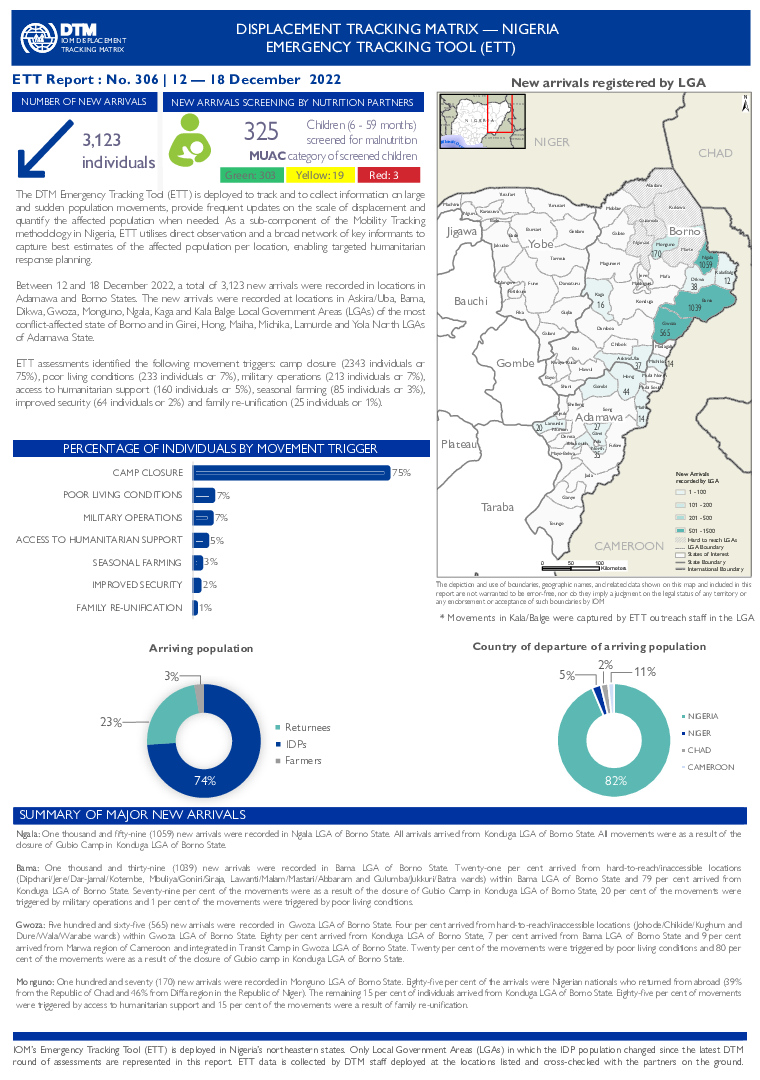
Contact
DTM Nigeria, AllUsersInDTMNigeria@iom.int
Language
English
Location
Nigeria
Period Covered
Dec 12 2022
Dec 18 2022
Activity
- Mobility Tracking
- Event Tracking
The DTM Emergency Tracking Tool (ETT) is deployed to track and to collect information on large and sudden population, provide frequent updates on the scale of displacement and quantify the affected population when needed. As a sub-component of the Mobility Tracking methodology in Nigeria, ETT utilises direct observation and a broad network of key informants to capture best estimates of the affected population per location, enabling targeted humanitarian response planning.
Between 12 and 18 December 2022, a total of 3,123 new arrivals were recorded in locations in Adamawa and Borno States. The new arrivals were recorded at locations in Askira/Uba, Bama, Dikwa, Gwoza, Monguno, Ngala, Kaga and Kala Balge Local Government Areas (LGAs) of the most conflict-affected state of Borno and in Girei, Hong, Maiha, Michika, Lamurde and Yola North LGAs of Adamawa State.
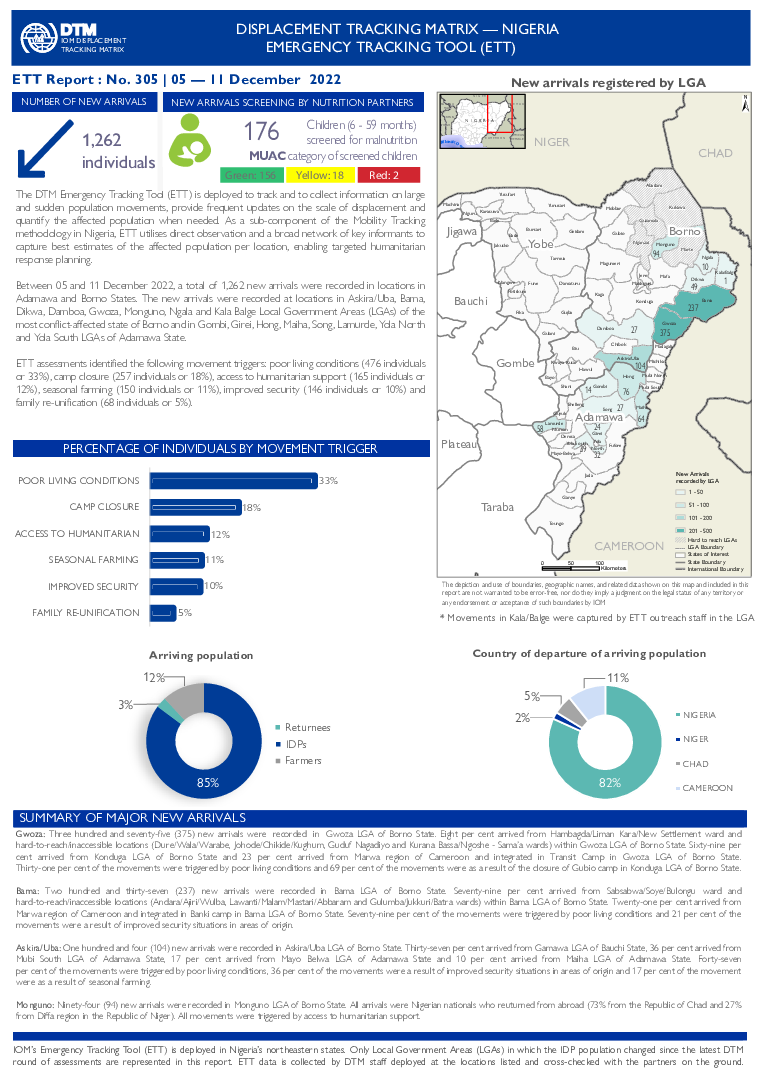
Contact
DTM Nigeria, AllUsersInDTMNigeria@iom.int
Language
English
Location
Nigeria
Period Covered
Dec 05 2022
Dec 11 2022
Activity
- Mobility Tracking
- Event Tracking
The DTM Emergency Tracking Tool (ETT) is deployed to track and to collect information on large and sudden population and sudden population movements, provide frequent updates on the scale of displacement and quantify the affected population when needed. As a sub-component of the Mobility Tracking methodology in Nigeria, ETT utilises direct observation and a broad network of key informants to capture best estimates of the affected population per location, enabling targeted humanitarian response planning.
Between 05 and 11 December 2022, a total of 1,262 new arrivals were recorded in locations in Adamawa and Borno States. The new arrivals were recorded at locations in Askira/Uba, Bama, Dikwa, Damboa, Gwoza, Monguno, Ngala and Kala Balge Local Government Areas (LGAs) of the most conflict-affected state of Borno and in Gombi, Girei, Hong, Maiha, Song, Lamurde, Yola North and Yola South LGAs of Adamawa State.
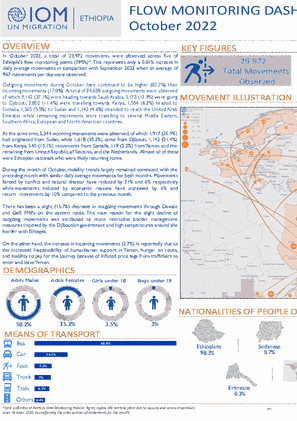
Contact
DTM Ethiopia, DTMEthiopia@iom.int
Language
English
Location
Ethiopia
Period Covered
Oct 01 2022
Oct 31 2022
Activity
- Flow Monitoring
In October 2022, a total of 29,972 movements were observed across five of Ethiopia's flow monitoring points (FMPs). This represents only a 0.01% increase in daily average movements in comparison with September 2022 when an average of 967 movements per day were observed.
Outgoing movements during October have continued to be higher (82.2%) than incoming movements (17.8%). A total of 24,628 outgoing movements were observed of which 9,142 (37.1%) were heading towards Saudi Arabia, 3,173 (12.9%) were going to Djibouti, 2,802 (11.4%) were travelling towards Kenya, 1,554 (6.3%) headed to Somalia, 1,365 (5.5%) to Sudan and 1,142 (4.6%) intended to reach the United Arab Emirates while remaining movements were travelling to several Middle Eastern, Southern Africa, European and North American countries.
At the same time, 5,344 incoming movements were observed, of which 1,917 (35.9%) had originated from Sudan, while 1,618 (30.3%) came from Djibouti, 1,142 (21.4%) from Kenya, 540 (10.1%) movements from Somalia, 119 (2.2%) from Yemen and the remaining from United Republic of Tanzania, and the Netherlands. Almost all of these were Ethiopian nationals who were likely returning home.
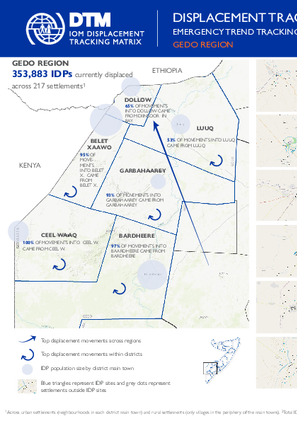
Contact
DTM Somalia, IOMSomaliaDTM@iom.int
Language
English
Location
Somalia
Period Covered
Dec 10 2022
Dec 14 2022
Activity
- Mobility Tracking
- Event Tracking
Since November 2021, 353,883 individuals have been displaced by drought in Gedo region. Since round 40, an estimated 4,482 IDPs arrived at the assessed settlements.
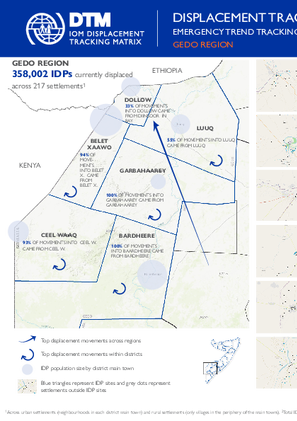
Contact
DTM Somalia, IOMSomaliaDTM@iom.int
Language
English
Location
Somalia
Period Covered
Dec 03 2022
Dec 07 2022
Activity
- Mobility Tracking
- Event Tracking
Since November 2021, 358,002 individuals have been displaced by drought in Gedo region. Since round 39, an estimated 18,457 IDPs arrived at the assessed settlements.
